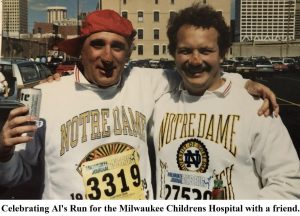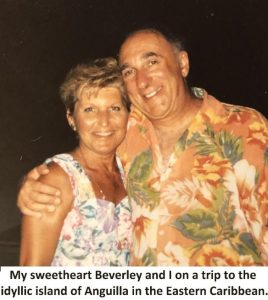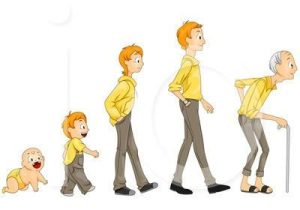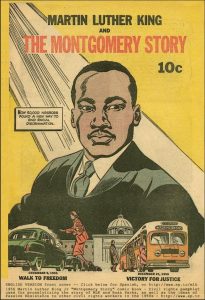THE VILLAGE TIMES
Independence Village of Olde Raleigh Resident Newsletter



Meet Dennis Gajewski
by Pat Simpson
 Meet new resident Dennis Gajewski, (pronounced-GUY-ef-ski), former advertising manager for Rolfs, a division of the Amity Leather Products Company (now the AR Accessories Group, Inc., best known as the maker of the Amity and Rolfs lines of personal leather goods). During his career Dennis helped the Rolfs Division overhaul its entire advertising strategy, thus helping sales to surge.
Meet new resident Dennis Gajewski, (pronounced-GUY-ef-ski), former advertising manager for Rolfs, a division of the Amity Leather Products Company (now the AR Accessories Group, Inc., best known as the maker of the Amity and Rolfs lines of personal leather goods). During his career Dennis helped the Rolfs Division overhaul its entire advertising strategy, thus helping sales to surge.
Dennis’s major activity since childhood has always involved art and advertising design – creating everything from custom leather wallets to several varieties of retail store display units.
“Advertising design is the creation of artwork used in ads,” says Dennis, “typically for products or services. Getting more specific, the goal of advertising design is primarily to drive sales, or an action that will eventually lead to a sale.”
Dennis has earned two nicknames over the years: “The Juice” and “The Old Fossil” (look for it on his 2nd-floor door). He has used his talents to study and create artwork from childhood through college, and through several industry-wide associations.
“I was born in 1942 in a hospital in Milwaukee, Wisconsin, the city where I grew up. My father, Ervin, was a photographer in the Navy. His brother, Ernie, was in the Flying Tigers during WWII and flew supplies to China over the eastern Himalayas (“The Hump”).

 “My mother, Bernice Rose Koral, had four brothers (all five now deceased). Her brother, Harvey Koral, loved to fly airplanes and by age seventeen was teaching others how to fly through the building of model airplanes. He later joined Captain Eddie Rickenbacker’s “Checkered and Tangled Birds” and flew a B-17 Flying Fortress during WWII as part of the 385th Bombardment Group
“My mother, Bernice Rose Koral, had four brothers (all five now deceased). Her brother, Harvey Koral, loved to fly airplanes and by age seventeen was teaching others how to fly through the building of model airplanes. He later joined Captain Eddie Rickenbacker’s “Checkered and Tangled Birds” and flew a B-17 Flying Fortress during WWII as part of the 385th Bombardment Group
In May 1945 the group dropped food to the starving Dutch population under Nazi occupation in the Netherlands as part of Operation Chowhound thus rescuing thousands of people during Hongerwinter or “hunger winter” in the closing days of the war.
Growing up, I went to Casimir Catholic School and later to the Layton School of Art, then regarded as one of the top five art schools in the United States. Among my favorite college teachers were Don Hay and Dr. Myaki, who taught me to ‘see with your eyes, not just your mind’
were Don Hay and Dr. Myaki, who taught me to ‘see with your eyes, not just your mind’
“I earned three scholarships in college and wrote my senior thesis on child seat belt devices, which didn’t yet exist. One day, a Ford Motor Company V.P. came by, heard about my thesis and picked up a copy. Saying, ‘Where did you learn about this?’ I explained that it was after many visits talking to nurses at the local children’s hospital. Later in my career I won a national award from the Alcoa Corporation for an aluminum tool design.
“I’m a three-timer; I’ve been married three times. For any number of reasons, I wish I had been more honest with myself. I have two children (by my first wife): Marnie, who is a very talented beautician and Dan, who has a PhD in Clinical Psychology and works in the Raleigh area. My most important life accomplishment, I believe, was getting my children to do the best they could.
children to do the best they could.
“I’m a very outgoing person; to earn extra money I was a summer lifeguard and have always been rather athletic, even spending time riding motorcycles with my friends.
“For 27 years I designed and created top-of-the-line leather items such as wallets, purses, briefcases and the like for the Amity Leather Products Company, based in West Bend, Wisconsin.
“But my life wasn’t just advertising,” says Dennis, “it was more than that.
“I spent part of my life as a teacher. What I would still like to do, if I could, is to teach design to pre-college students at MIAD (Milwaukee School of Art and Design). However, what I would still like to do, more than anything else, is ride my bike.
“I recently made Independence Village my new home thanks to my son Dan’s help.
“Life isn’t always about work. I hope I’m never too busy for my sweetheart Beverley.”
Resident Ramblings
Disclaimer: The information contained in this newsletter represents the views and opinions of the original creators of such information and does not necessarily represent the views or opinions of Independence Village nor does it constitute an endorsement by Independence Village or its affiliates of such information.
The 1619 Project Revisited
– by Richard Smalto
Why does the current culture maintain the view that American society is racist when it is a self- evident truth it is not. Racism implies oppression and inequality based on color. Oppression is structure based on victimization. You can divide people and immobilize certain constituents based on victimization. If you divide people you can conquer from within. Our way of life and our institutions are threatened by political factions that cannot succeed unless they use the same institutions that unite us to divide us.
racist when it is a self- evident truth it is not. Racism implies oppression and inequality based on color. Oppression is structure based on victimization. You can divide people and immobilize certain constituents based on victimization. If you divide people you can conquer from within. Our way of life and our institutions are threatened by political factions that cannot succeed unless they use the same institutions that unite us to divide us.
We have succeeded as a society not because we are racist and have used free enterprise to prosper but because we have used the scientific method of reasoning to determine how to organize our institutions. This way of thinking which is a feature of western culture has enabled the occidental part of the world rather than the oriental part of the world to dominate. The scientific method of reasoning which promotes clear thought has enabled the west to minimize oppression by establishing a form of justice that differs throughout most of the rest of the world. In the United States and Britain you are innocent until proven guilty whereas in other parts of the world, the presumption is you are guilty until you prove you are innocent. You could spend the rest of your life in prison trying to prove you did not commit a crime whereas while you are free and on trial a single fact introduced by the prosecution can convict you.
Capitalism, economic prosperity and technological superiority emanate not from racism and oppression but from a pattern of clear thought. The way Americans think is why they lead the world in innovation and why they prosper and it is the reason why all races and all creeds yearning to be free rejoice when they say ‘I’m going to America!’
Growing Old Gracefully?
– by Frank Howes
I’m winding down. My hearing is poor, even with my hearing aids. My hair, what I have left of it, is going grey. I can’t read without my glasses. My teeth are slowly grinding and breaking away. Aches and pains in my hips, knees, feet, and back plague me. I can no longer pee freely, but when I realize that I should have gone 10 minutes ago. My pill dispenser is much too full. I worry about if I’ll have enough money to live ‘til a ripe old age. My balance is not as good as it was a few years ago. And I get lonely sometimes.
even with my hearing aids. My hair, what I have left of it, is going grey. I can’t read without my glasses. My teeth are slowly grinding and breaking away. Aches and pains in my hips, knees, feet, and back plague me. I can no longer pee freely, but when I realize that I should have gone 10 minutes ago. My pill dispenser is much too full. I worry about if I’ll have enough money to live ‘til a ripe old age. My balance is not as good as it was a few years ago. And I get lonely sometimes.
Worst of all, my memory is starting to go, at least I think so, but I really don’t remember. I’ve forgotten the things I don’t remember, so it’s not so bad. My memory is a bit selective I think, mostly I remember what I want to remember, but not always. Sometimes I can’t recollect the things I want to recall. And sometimes I have nightmares about the stupid things I’ve done in my life. Do you have such dreams?
How did I get this old? What will it feel like to get even older? And why should I complain? I’m one of the youngest people here at Independence Village.
I look around me and see people with thousand-mile stares looking into the distance. What do they see? Will I have that stare in a few years? Two weeks ago my siblings and I put my mother into a skilled care facility. Her memory is mostly gone; she can’t walk very well, and she is very incontinent.
In spite of it all I still have hope. Maybe I’ll forget more of the things I don’t remember. Will I still be happy then?
The Montgomery Story
– by Pat Simpson
 In the “Letter from Birmingham Jail”, an open letter written on April 16, 1963, Martin Luther King Jr. says that people have a moral responsibility to break unjust laws and to take direct action rather than waiting potentially forever for justice to come through the courts. King writes: “Injustice anywhere is a threat to justice everywhere.”
In the “Letter from Birmingham Jail”, an open letter written on April 16, 1963, Martin Luther King Jr. says that people have a moral responsibility to break unjust laws and to take direct action rather than waiting potentially forever for justice to come through the courts. King writes: “Injustice anywhere is a threat to justice everywhere.”
It’s not well-known that six years earlier, Martin Luther King and the Montgomery Story was published, a graphic comic book that helped spark a generation of young civil rights didn’t feature superheroes, but a 42-year-old seamstress and a 26-year-old Baptist pastor. Printed in 1957, the comic book gives an account of the 13-month Montgomery Bus Boycott, which began after police arrested civil rights activist Rosa Parks for refusing to yield her bus seat to a white man. The successful protest that ended segregation on Montgomery’s buses propelled the young pastor who led the movement, Martin Luther King Jr., to national fame.
Brothers Hassler and Benton Resnik worked together on the text, while artist Sy Barry, best known for his work on The Phantom comic strip, illustrated the book. King, himself, not only approved of the project, but made small editorial changes to the script. The text detailed the bus boycott and included practical instruction on how activists could use the nonviolent “Montgomery Method” of protest to bring about social change.
The text in the book begins with:
“In Montgomery Alabama 50,000 Negroes found a new way to work for freedom without violence and without hating. Because they did, they put new hope in all men who seek Brotherhood, and who know you don’t build it with bullets. No one person made the Montgomery story but one man’s name stood out among the 100 who worked so hard and unselfishly. That man was 29-year-old Martin Luther King Jr., minister of the Dexter Avenue Baptist Church and president of the Montgomery Improvement Association.”
The idea of non-violent resistance (aka) civil disobedience as a way of exalting the law of conscience over civil law was nothing new. Philosopher, naturalist, poet and rugged individualist, Henry David Thoreau (1817-1862) inspired generations of readers to think for themselves, to follow the dictates of their own conscience.
Leo Tolstoy (1828-1910), author of War and Peace and Anna Karenina, expressed similar ideas on nonviolent resistance, and had a profound impact on such pivotal 20th-century figures as Mahatma Gandhi.
Mahatma Gandhi (1869-1948), Indian lawyer, anti-colonial nationalist and political ethicist, employed nonviolent resistance to lead the successful campaign for India’s independence from British rule. He inspired movements for civil rights and freedom across the world.
And the list goes on with other notables such as anti-apartheid activist Nelson Mandela, first President of South Africa; Lech Wałęsa Polish statesman, dissident, and Nobel Peace Prize laureate, who served as the president of Poland between 1990 and 1995; and Egyptian activist Dalia Ziada, whose actions during the 2011 Arab Spring resulted in the resignation of Egyptian President Hosni Mubarak.
The Fellowship of Reconciliation distributed 250,000 copies of the graphic comic book to schools, churches and civil rights groups. Beyond U.S. borders, it eventually inspired anti-apartheid protests in South Africa before the government banned the comic book’s possession. The Fellowship of Reconciliation distributed Spanish-language editions in Latin America
Among the comic book’s early readers was an 18-year-old student activist named John Lewis. Lewis received a copy while attending a 1958 Nashville workshop to prepare for the freedom rides, lunch counter sit-ins and other nonviolent protests. The civil rights pioneer went on to share the dais in front of the Lincoln Memorial with the hero of that comic book during the 1963 March on Washington, and two years later Lewis and King marched side by side from Selma to Montgomery.